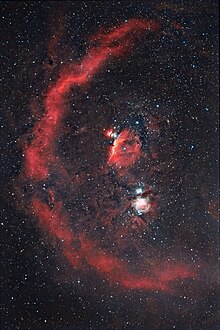巴纳德环
(重定向自巴纳德环)
巴纳德环(Barnard's Loop, Sh 2-276)是位于猎户座的一个发射星云。它是包含了马头星云和明亮的猎户座大星云的猎户座分子云复合体的一部分。巴纳德环是一个巨大的弧型结构,并且中心点大致位于猎户座大星云。猎户座大星云中的恒星可能与气体被电离形成巴纳德环的机制相关联。
| 星云 | |
|---|---|
 巴纳德环为影像中弥散红色云气半圆结构。 | |
| 观测资料: J2000 epoch | |
| 赤经 | 05h 27.5m |
| 赤纬 | -03° 58′ |
| 距离 | 518或1434 光年 |
| 视星等 (V) | 5 |
| 视尺度(V) | 10° |
| 星座 | 猎户座 |
| 物理性质 | |
| 半径 | 50或150光年 ly |
| 名称 | Sh 2-276 |
概要
编辑从地球看,巴纳德环延伸超过600角分,几乎覆盖了整个猎户座。但其亮度极低,无法以肉眼看见,必须透过长时间曝光摄影方能清楚地看到这个星云。1895年,美国天文学家爱德华·爱默生·巴纳德从经过长时间曝光的底片上发现了这个星云。
目前的研究认为巴纳德环距离地球为159秒差距(518光年)[1]或440 秒差距(1434光年)[2],这取决于其直径为100或300光年而定。巴纳德环被认为可能源于约200万年前的一次超新星爆炸。该次超新星也可能产生了数颗速逃星,包含御夫座AE、天鸽座μ、白羊座53。一般认为前述恒星和巴纳德环的前身恒星曾经是多合星系统的一部分,其中一颗恒星爆炸成为超新星[3]。
虽然较早期的天文学家确实观测到巴纳德环这个亮度不高的星云,但它的名称来自于天文摄影的先驱爱德华·爱默生·巴纳德,他在1894年拍摄了这个星云并发表了文章描述它[4]。
图片集
编辑-
本条目资讯框影像的红色波段被取代为黑白后的呈现。
-
巴纳德环与猎户座主要恒星以及猎户座大星云。
参考资料
编辑- ^ Wilson, B.A.; Dame, T.M.; Masheder, M.R.W.; Thaddeus, P. A uniform CO survey of the molecular clouds in Orion and Monoceros. Astronomy and Astrophysics. 2005, 430: 523–539 [2018-03-09]. Bibcode:2005A&A...430..523W. arXiv:astro-ph/0411089v1 . doi:10.1051/0004-6361:20035943. (原始内容存档于2018-12-12).
- ^ O'Dell, C.R.; Ferland, G.J.; Porter, R.L.; van Hoof, P.A.M. Physical Conditions in Barnard's Loop, Components of the Orion-eridanus Bubble, and Implications for the Warm Ionized Medium Component of the Interstellar Medium. The Astrophysical Journal. 2011, 733 (1): 9 [2018-03-09]. Bibcode:2011ApJ...733....9O. arXiv:1103.2789 . doi:10.1088/0004-637X/733/1/9. (原始内容存档于2020-06-14).
- ^ The Internet Encyclopedia of Science: Barnard's Loop (Sh 2-276). David Darling. [2008-04-22]. (原始内容存档于12 March 2008).
- ^ Barnard, E. E. The great photographic nebula of Orion, encircling the belt and theta nebula. Popular Astronomy. 1894, 2: 151–154. Bibcode:1894PA......2..151B.
- Gaylard M.J. (1984), Detection of the H 142-alpha line from the Barnard Loop, Monthly Notices of the Royal Astronomical Society, v. 211, p. 149
- Reynolds R.J., Ogden P.M. (1979), Optical evidence for a very large, expanding shell associated with the I Orion OB association, Barnard's loop, and the high galactic latitude H-alpha filaments in Eridanus, Astrophysical Journal, v. 229, p. 942